I’ve borrowed my dockmate’s electric dinghy. I bought my wife an e-bike and I know she would like an electric motor. Small gas motors can smell the fear of those that lack confidence with a manual choke. Gas motors are loud and you have to handle gas. My last boat kept her tender on davits and we always thought it would be neat to just plug in at night. The range is enough to commute from the harbor to the nearest dinghy dock, or from at anchor to the nearest beach. But what about the longer explorations to hidden beaches and snorkeling spots? What about small sailboats that will use the motor not just in and out of the harbor, but also when becalmed? Clearly, the best choice depends on your needs, so let’s see how they stack up.
SELECTION CRITERIA
Effective horsepower. Horsepower calculated from electric draw times typical motor efficiencies are about ½ what manufacturers claim as effective horsepower. On the other hand, direct drive electric motors avoid drive train loses and they are fitted with more efficient props, narrowing the gap. Boat tests and user reports agree electric motors with the same rated equivalent horsepower are slightly slower, but accept the lack of performance because “it’s so quiet.” Electric outboards typically have more low speed thrust, but they don’t have the top end output. We suggest derating effective horsepower claims by about 1/3. For example, a 4 HP gasoline outboard will run with a 6 HP. There’s no magic that get’s electric outboards completely around the 745.7 input watts = 1 input horsepower conversion factor. They work because most dinghies are fitted with more horsepower than they need in calm conditions.
Propellers. Electric outboard propellers tend to be a bit larger in diameter, higher aspect ratio, and run at lower RPM than gasoline outboards of the same size. This increases efficiency at low boat speed, but at higher speeds, where cavitation and ventilation are factors, conventional prop designs still rule. They are polymer or composite, but that does not make them fragile. They won’t take the abuse shallow water fishermen put them through, hitting sand and powering through weeds, but we’ve heard of few breakages. Small gas outboards have long used composite props, and we’ve run those through the mud more than we should have without damage. Of course, they are smaller in diameter and the blades are shorter. The way I see it, Mercury, Evinrude, and Honda have smart guys, and if something as simple and cheap as a more efficient prop would make them faster than the competition, they would do it. Obviously, there are compromises.
Drive Systems. Direct drive is quieter, because the motor is under water and there are no gears. The trade off is increased vulnerability to corrosion and a general reduction in total life expectancy vs. top driven outboards. Direct drive is well proven in trolling motors, though life expectancies are limited in saltwater. Our guess and the experiences we’re hearing is that gasoline outboards last longer.
Charging. Cruisers need the ability to recharge their tender batteries overnight from the main bank. ePropulsion has a separate input for solar charging, but unless it is a small boat on a mooring, most likely the panels will be connected to the mother ship. As a practical matter, you will charge using a dedicated 120V charger run off an inverter, accepting the small conversion loss. Unavoidably, recharging adds strain to both battery capacity and charging energy sources. You’ll need more solar or wind. A weekend daysailer will either plug in or add enough solar to recharge during the week.
When cruising, we typically used about 1/3 tank (one pint) of gasoline per day in my Mercury 3.5 tender motor. Some days it might be as much as ½ gallon, sometimes only a few ounces, but in general I have to fill it up every other day. This is equivalent to 1/2 charge on a self-contained electric outboard, about 500 Wh, or about 50 Ah on your 12 volt battery bank, after inverter efficiency and charging hysteresis are factored in. I’ll need an extra 100-120 watts of solar and one to two more house batteries to power the dinghy. Doable, but a modification you’ll need to plan for. If you use your dinghy heavily and make long trips, the dinghy will need supplemental battery capacity and charging requirements will increase.
Larger electric outboards use more power. My F-24 has a 4hp Honda with a 3-gallon external tank. Though I use the motor only to exit the harbor and manage sails, I seem to go through about one half gallon each daysail. This is twice the requirement of the dinghy we just discussed, or about 100 Ah on a 12 volt bank. Assuming 5 hours at 100% rated output (an accepted industry estimation of solar output) it will require 200 watts of solar panels dedicated to outboard charging, and 6-8 hours to accomplish the charging. I’d need to add 2-3 batteries, and a few cloudy days would still risk a dead battery. If the wind dies on day two, we’ll just have to wait until it returns, since we have no reserve for motoring through calms. Running a generator to charge is possible but ironic.
ePropulsion offers hydrodynamic charging, putting amps back into the battery at the cost of drag and slower sailing. But considering the way outboards bounce up and down in waves in a breeze I’m skeptical. I’d rather squeeze in one more solar panel, but this could help boats that lack the deck space.
Lithium vs. Lead Acid Batteries. A few of the manufacturers—Elco, Hangkai, and Minn Kota—recommended lead acid batteries, because they still offer the best ratio of dollars per unit capacity. They are still the standard for industrial forklifts and solar installations. But they are heavier, cannot be cycled below about 40% state of charge without serious lifespan reduction, don’t last as long, and charge more slowly. For a light dinghy or sport boat, lithium is the better answer. Installed low in the bilge of a displacement cruiser, a few lead acid batteries won’t hurt a bit.
Range. We saved this for last because the pro-electric crowd hates the topic. I understand the benefits, but I’ve also run low (not out) of gas, and it’s not like someone can pass you a jerry can. One of my fellow Corsair F-24 trimaran sailors has both gas and electric outboards. He likes the electric (EVO spirt 1.0) for the quiet and ease of use, but also has a 4 hp 4 stroke Tohatsu to satisfy the race committee’s requirement that the boat can be driven at hull speed for 4 hours. The battery lasts only an hour (5 miles), whereas a 3-gallon tank lasts more than 7 hours while going faster (50 miles), and he can easily carry an extra 5 gallons, providing ample range for cruising. On the other hand, most days he needs only 20-30 minutes, enough to get in and out of the marina. Relevant to tenders, if you are strictly commuting from the mother ship to a dinghy dock within sight, no worries, but if you like to visit distant beaches or explore, you’re going to have to plan on and pay for more batteries.
AN E-OUTBOARD SAMPLING
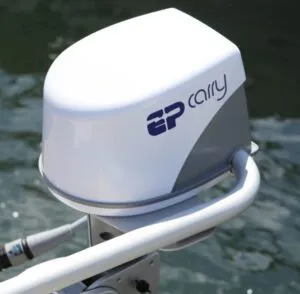
Dubbed the “electric paddle,” it is light, less powerful, competitively priced, and we’ve heard all good things. I’ve only used it once, and though it was not powerful, it moved a small hard dinghy well in the harbor and was light as a feather. Compared to a trolling motor, it is far more user friendly. The best choice if you value easy handling and don’t need power.

The best know manufacturer, with the longest track record for self-contained electric outboards, with a less-than-enviable reliability record. The original Traveller was plagued with a variety of mechanical and electrical problems. The redesigned Traveller 1103C switched to a direct drive, like a trolling motor, and seems to have solved many of the original’s problems, but we’re still hearing some complaints and doubt they will match the 10- 20-year life expectancy of a well-cared-for gasoline outboard.
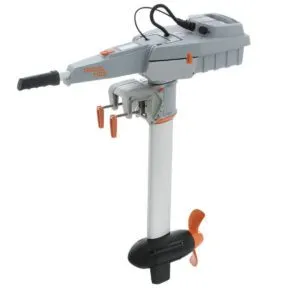
Corrosion will get to something, the plastic parts will crack, and certainly the battery will need to be replaced. A friend of mine received a Traveller for free because the battery failed in less than a year and the original owner had become frustrated (the factory, to its credit, eventually replaced the battery for free). He likes rowing his hard dinghy, and the motor just got in the way. Add the complication of charging, he gave it away. Several years later, he remains happy with his decision.
The Travel models use integral batteries, and the Cruise line uses external batteries. All use direct drive. The Cruise line requires the installation of a remote throttle. Torqeedo also makes sail-drive and shaft-drive inboards.

Resembling a stick with a propeller on the end, at just 12 pounds, it’s half the weight of anything and takes portable to a new level. Instead of clamping to the transom, the TEMO fits quickly into an oar lock-like fitting, and you steer by moving it side to side like a steering oar. This felt odd at first, but after a while we were maneuvering around the piers with ease. The power and range are very limited. On the other hand it is barely heavier than a glass of milk and runs in very shallow water. Outside the box, for certain.
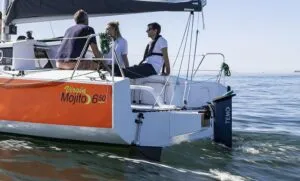
Once again, thinking outside the box, the TEMO 1000 has a 360 degree rotating bracket that you pre-mount on the boat, making it lightning fast to demount. At just 1.3 estimated equivalent horsepower, this is not a powerhouse, but it could be a slick way to move a tender around the harbor. Not tested.
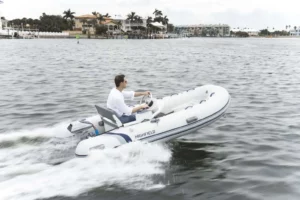
At first glance it is a Torqeedo look-alike, but it’s is not a clone and the engineering is different. Though only on the market 6 years, we’ve heard few reports of trouble. For example, the Spirit has sturdier electrical connectors, more range, and faster charging, making it the winner in the early going.
The 6-HP Navy 3.0 is available with a tiller, eliminating the need for a remote throttle and allowing direct steering for tight maneuvering. Like Torqeedo, ePropulsion also makes pod drives up to 6 kW. Pricing is 20-35% less than Torqueedo.

Long established, Elco has been building electric drives for 130 years, long before electric was cool. Mostly, I’ve seen shaft-drive inboard units in launches and taxies. The 5 HP is based on a proven Yamaha gas outboard frame, and Elco knows how to make durable electric drives. It’s not light, and the recommended lead acid batteries drive the total weight even higher, but you can expect reliability and solid performance. Perhaps the best choice if easy portability is not important.
THE DISCOUNT WAY
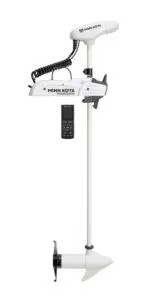
Minn Kota has been making trolling motors since before I was born, and mostly they last. The Riptide is a transom mount saltwater version, so it should stand up to corrosion, but don’t expect a lot of oomph on open water. Like the EP Carry, it is a good harbor motor and cheap as chips, but not as user friendly because of the need for an external battery.

Hangkai makes a 4 HP electric for a bargain price. A guy down the dock got one this spring, paired it with some batteries he got for free when a yacht repowered with lithium, and for a total under $400, he’s scooting around the harbor in good style. In a few years we’ll know more about durability.
Gasoline 4-strokes. Tohatsu (which makes small outboards for Merc, Evinrude, Yamaha, and Nissan) are the standard for comparison. I’ve had all of them. Feed them clean gas (keep the vent closed when not in use, turn over the gas by sailing often, and use a quality anticorrosion additive) and they run and run. They are louder than electrics and vibrate more, they are slightly heavier than the self-contained electric outboards, but are lighter in larger sizes when the external battery weight is included, and have far greater range if an external tank is attached. Even a 1-liter aluminum fuel can under the seat adds considerale range and back-up safety. A better solution for daysailers and dinghies that will take longer trips or cross open water.
Summary. The EPropulsion Spirit 1.0 has some fans, but others have found it under powered. We’ve heard of too many Torqueedo failures to recommend them. The Elco 5 has proven durable but it’s not flashy.
For that last 15 years I’ve been telling myself my next outboard might be electric. If I had a small dinghy I lifted on deck every night, perhaps I would. But for a dinghy easily lifted with davits or a daysailer, I’m not seeing it. I compare the specs, look at the track history, and asking myself “why I would pay more for less?” I’d love the quiet on protected waters, but I’d miss the power and range outside. It boils down to personal needs and wants.



































Have had a Torqeedo Travel 1103 for nearly three years now and it’s worked perfectly with our 10-foot RIB (knock wood). Torqeedo released a solar panel connector cable last year, making charging it off grid much easier. Is it lighting fast? No, but I certainly knew that going in. Gets us back and forth to dingy docks and hasn’t let us down gunkholing yet. I know a guy that has one attached to his small sailboat and he claims he can get 4-6 hours out of it on a single charge, using very low wattage. Not sure I’d ever attempt that, but for a RIB it’s perfect.
Here’s another vote for the Torqueedo Travel 1103. I’ve had mine immersed in salt water twice- once to a depth of 3 meters. Both times it just took a quick fresh water rinse, a squirt of CRC electronics cleaner into the connectors, and a few shots of WD40 into the swivel points and it powered right up. Torqueedo’s advertised IP67 is legit.
What about the new to release Mercury electrics??
I have had a Torqueedo Travel for over 5 years and love it. I originally bought it for my J24 to power it in and out of the harbor for racing and it was great for this function pushing the boat over 4 knots easily and with a 3-4 mile range at that speed. More if run slower. I liked it so much that I sold my gas outboard for the dinghy and now use it for my inflatable when I cruise on my Catalina 400. No gas on cruises and works awesome for bringing the family back and forth to the beach and town. Last year spent a week in Newport on a mooring and never had to charge going back and forth all day. Plus, you can take the battery off separately and you don’t have to horse a heavy gas engine off your transom and onto the dink every port you go to. I can step from the swim platform to the dink with the motor in one hand. Now if you were taking trips miles away on the dink, or want to plane it out, it would not be a good choice, but I cannot recommend it enough for a coastal cruiser going port to port. And I don’t have to bring smelly gas on my sailboat OR mess with ethanol issues.
We’ve given our Epropulsion Spirit a good workout the past 3 years, impressed with its ability to push hard against some pretty strong tides for quite a distance. Rather than speed and mileage, the LCD screen tells you how many hours you can go on for at the present throttle setting, which we’ve found to be useful. We’ve cruised a lot in places where the idyllic upper reaches of rivers can be explored in peace & quiet. I hate having gas on a sailboat, and in many places we go gas is hard to find anyway. Charging has never been a problem; we plug it into the inverter whenever the engine is running or when the solar has topped up the batteries. We’ve particularly enjoyed being able to quickly separate the battery from the leg, making it so much easier to carry the tender up the beach or stow the unit onboard with the weight better distributed.
Torqueedo works until it doesn’t. Then you are literally up the creek without a paddle or tech support. My 1003 worked for a couple of years, then one day it didn’t. Tech support took forever to get ahold of and didn’t have many suggestions for diagnosing it. They thought it was the throttle after I checked some pin voltages. I bought a new throttle and it didn’t help. I finally saw someone up the dock with one and asked to borrow the battery. Sure enough, that was it. Torqeedo said they had a recall on them, but wouldn’t send me a loaner or replacement until I mailed mine in for testing, which is a real hassle since you need a special box and carrier due to the lithium batteries. When they finally tested it, months later, the dealer/service guy said the recall was only for water intrusion, and mine was just faulty. It held a complete charge in the days and weeks before it stopped working. The service guys said the batteries are good for about 4-5 years. A new one was $1000. So how much gas can you buy for $1K over 4 years? I don’t know about anyone else, but I never spent $250/year on dinghy fuel. Maybe 10-20% of that. So if the battery is only good for 4-5 years as their service agent said – it completely blows the economics of something that is already a lot more expensive than a gas equivalent. Not to mention the 12 months without it working while I went ’round and ’round with them. Luckily I had another small outboard to use while playing with it. No more Torqueedo for me – ever.
Our 3 year old Torqeedo replaced a 4 stroke Mercury that my wife just couldn’t start, so the electric outboard is the perfect answer. So far it has been fault free, allows silent travel – I hate the din from a petrol outboard and I can recharge on board from my 12v house battery bank while my solar panel tops them up. No stink of petrol, no annual servicing costs, far easier to fit on and off the tender and the range is fine for typical yacht to shore (pub) trips. If you have your petrol outboard Dealer serviced every year you will pay for a new battery when the time comes. There’s no going back for me.
I had a dockmate that got a free Torqueedo from a freecycle bin. All it needed was a new battery and a connector. He used it for a few months, it worked fine, and then he returned it to the freecycle bin, since he was comfortable rowing his hard dink and it seemed like a complication to him. Different strokes.
It seems to come down to whether the user is a small engine whisperer, whether they have learned the gas additive and fuel management tricks from PS testing, and whether they value quiet, or power and range more. No single answer. I get along very well with gas motors, but my spouse less so. Many need more power or range, but no one likes the noise. It’s a puzzlement.
We have an Epropulsion Spirit 1.0 On a Highfield 3.1 Classic. Easy to use, has the range we need and oh the quiet. We did purchase the epropulsion fast charger to shorten the recharging time. The highfield has a raked transom and the motor will not pitch up enough to beach the without sticking the prop/motor in the sand. We have sometimes resorted to removing the Spirit just to drag the dink up the beach.